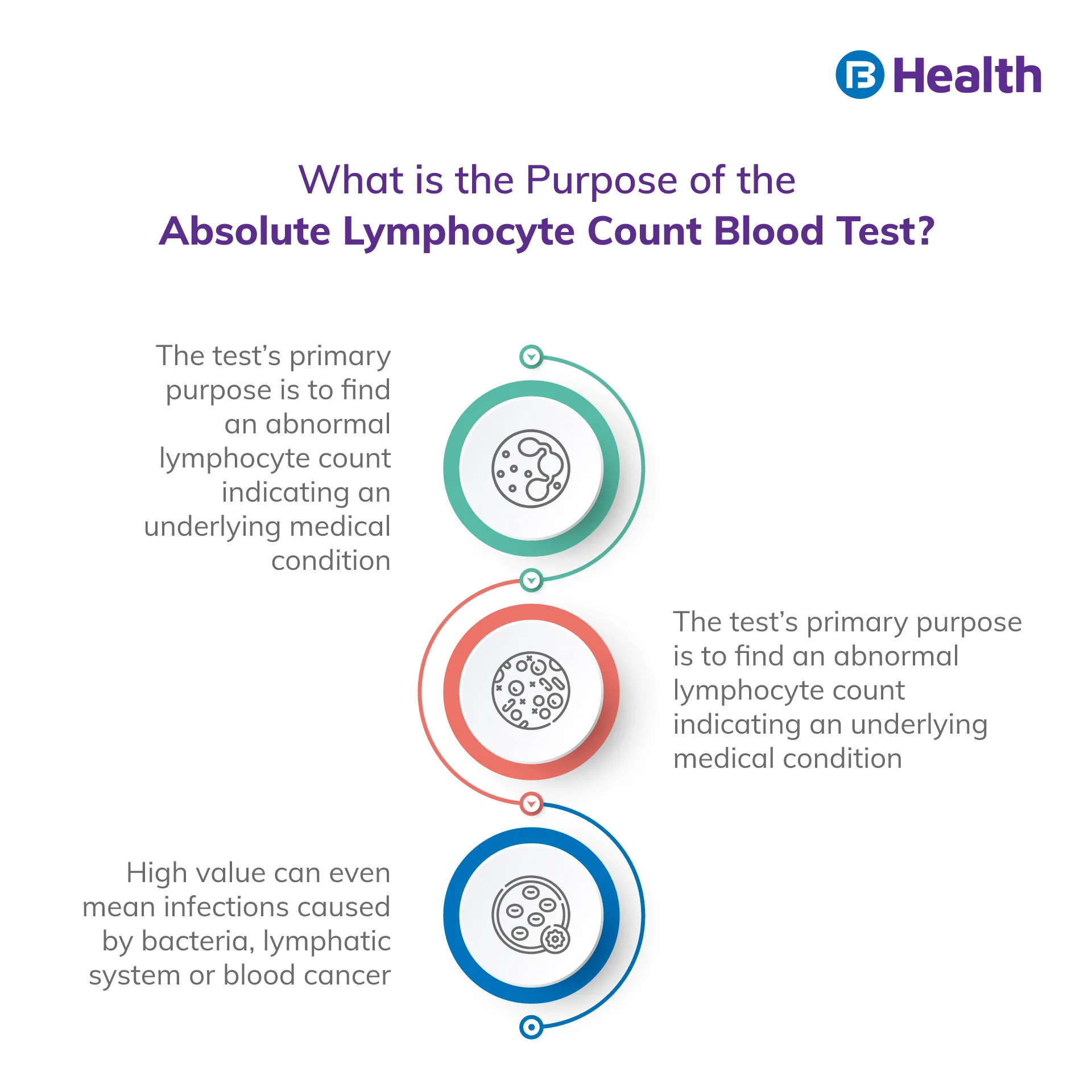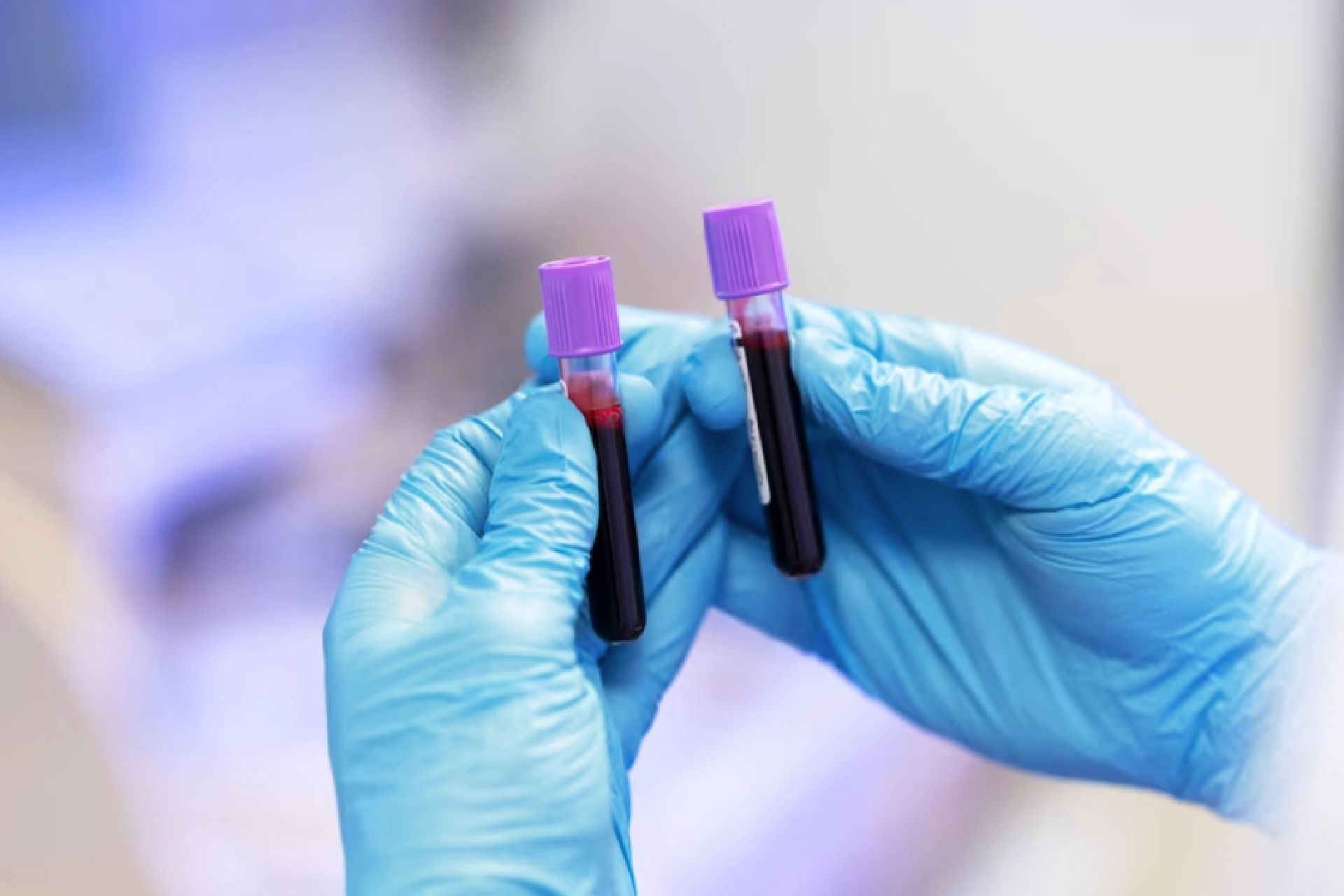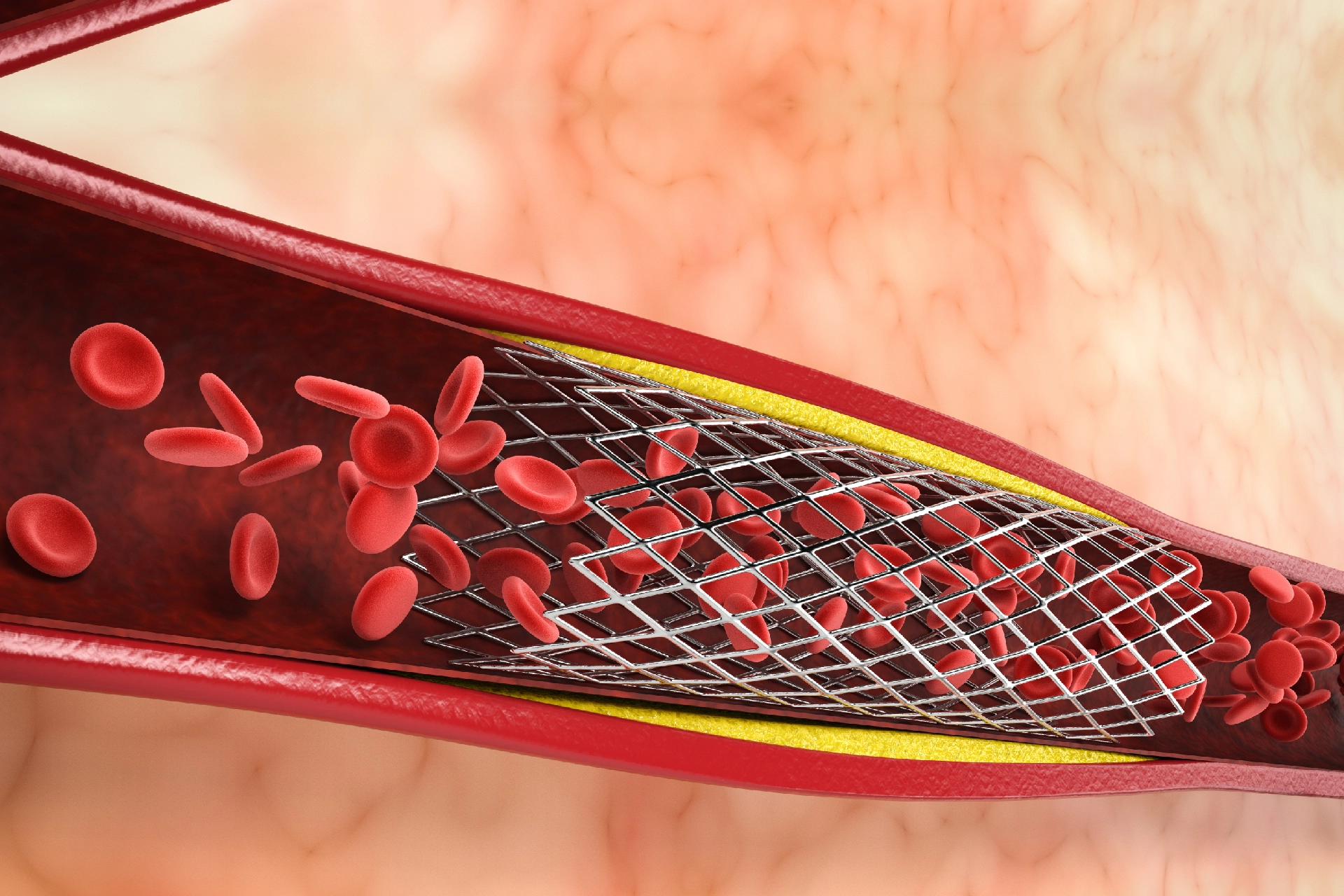Health Tests | 7 min read
Absolute Lymphocyte Count Test: Normal Range and Levels
Medically reviewed by
Table of Content
Synopsis
The absolute lymphocyte count normal range is the key to good health, as high or low counts indicate illness due to infections, injuries, or toxins in the body. Therefore, evaluation of the absolute lymphocyte count is critical to diagnosing the underlying medical condition and its management.
Key Takeaways
- Absolute lymphocyte count normal range is used to diagnose illnesses
- Absolute lymphocyte count high level indicates the body is fighting infection
- Absolute lymphocyte count low level indicates severe medical conditions besides stress
The body’s immune system responds to threats of infection and disease using the white blood cells protecting the body from harmful bacteria and viruses. Lymphocytes are among the significant components of the white blood cells circulating through the bloodstream. Thus, a high or low over the absolute lymphocyte count normal range signifies an underlying health condition requiring immediate attention. Several diagnostic tests determine lymphocyte count, but let us first understand what they are.
What are Lymphocytes?
Lymphocytes are white blood cells developing in the bone marrow and thymus and forming a part of the body’s immune system. Lymphocytes make up 20 to 40% of the total blood volume, but tests determine the absolute lymphocyte count normal range in circulation. High lymphocyte count is lymphocytosis, indicating infection or other underlying medical conditions like leukemia. On the other hand, viruses or other factors like fasting and severe physical stress can result in a reduced count called lymphocytopenia.
Types of Lymphocytes
There are three types of lymphocytes, namely:
B Cells
The cell originates in the stem cells and bone marrow. Their primary function is making antibodies – a protein of the immune system which fights foreign bodies called antigens. Each B Cell produces a specific antibody matching an antigen for destruction
T Cells
The cell originates in the stem cells and the bone marrow, which transforms into T Cells after traveling to the thymus. The primary function of T Cells is to kill cancer cells and manage the immune response to a foreign organism. In addition, the T Cells destroy cells taken over by viruses or cancer
NK Cell
With origin similar to the other lymphocytes, these cells respond quickly to foreign substances, especially targeting and killing cancerous and virus-infected cells
Doctors usually prescribe blood tests to evaluate various components, including red blood cells, white blood cells, platelets, and hemoglobin, to diagnose a medical condition. An imbalance- in the reference range indicates the presence of infections and toxins in the body, which need treatment. Since lymphocytes are a major constituent of the immune system, the absolute lymphocyte count is the benchmark test for determining its level in the bloodstream. So, let us find out what the test means.
Additional Read: Antinuclear antibodies blood test
Absolute Lymphocyte Count Lab Test
The lab test requires the collection of blood samples to measure lymphocyte levels among the various white blood cell types. The body’s immunity relies significantly on white blood cells fighting antigens like bacteria, viruses, and toxins causing sickness. However, a weak immune system means inadequate white blood cells in the bloodstream, indicating infections like tuberculosis, leukemia, and lymphoma, to name a few.
Thus, a weak immune system with lymphocyte imbalance makes the body vulnerable to infections and diseases. The premise applies when the outcome shows both the absolute lymphocyte count high reading and the absolute lymphocyte count low reading.
The brief description below comprises the commonly prescribed diagnostic blood tests to measure absolute lymphocyte count.
Absolute lymphocyte count
The complete blood count (CBC) also determines the absolute lymphocyte count while measuring the various blood components mentioned below.
- Red blood cells (RBC)
- White blood cells (WBC)
- Platelets (blood clotting cells)
- Hemoglobin (an oxygen-carrying protein)
- Hematocrit (the ratio of RBC to the blood fluid – plasma)
The absolute lymphocyte count denotes a whole number instead of a percentage. So, you get the desired figure by multiplying the total number of blood cells and the WBC percentage comprising lymphocytes.
Doctors also refer to the Packed Cell Volume (PCV) or hematocrit result to tell the ratio of RBC in the blood. Moreover, deviation from the PCV test normal range indicates certain diseases like anemia.
Additional Read: CRP (C-Reactive Protein) Normal RangeFlow cytometry
The test requires special instruments to look at the different types of blood cells. It is more detailed than the CBC and measures the different types of lymphocytes in the following steps.
- The lab technician suspends the collected blood sample in a fluid and passes it through a laser flow cytometer
- The laser and detectors scatter the blood cells into patterns making the different cell counts easy
- The instrument analyses thousands of cells in minutes, calculating the cell mass in the blood
Preparation for Absolute Lymphocyte Count Blood Test
The test does not require any preparation, as a collection of the blood sample is relatively simple and painless. However, informing the doctor about the consumption of medications or allergies is imperative before conducting the test. In addition, it is comfortable to wear a loose half-sleeve shirt to help the phlebotomist to draw the blood sample.
Procedure for collecting absolute lymphocyte count blood test sample:
You can visit the lab to provide the blood sample or ask for home collection as the procedure is uncomplicated, needing just a few minutes:
- The phlebotomist ties a band on the upper arm above the elbow pit to make the vein visible
- The phlebotomist pierces a needle into the vein after locally sterilising the area with 70% alcohol and collects the blood sample into a sterile container
- The lab receives the blood sample for analysis and discards the needle and syringe for immediate hygienic disposal
Most Indian diagnostic laboratories conduct absolute lymphocyte count blood tests at a cost varying between Rs.100 and Rs.300, depending on the location.
Additional Read: Importance of Rapid Antigen Tests
Absolute Lymphocyte Count Normal Range
The doctor’s primary concern is looking for numbers out of the normal range in the test report. That makes understanding the absolute lymphocyte count normal range based on age. Accordingly, they are:
- Adults: Between 1000 and 4800 lymphocytes per microlitre of blood
- Children: Between 3000 and 9500 lymphocytes per microlitre of blood [1]
The doctor prescribes additional tests if an abnormal lymphocyte count emerges from the test. So, both the absolute lymphocyte count high and the absolute lymphocyte count low deserve added attention, and the doctor will ask a few questions before recommending further investigations.
- Was the patient sick or exposed to a contagious disease recently?
- What are the discernible symptoms?
- How long have the symptoms been continuing?
Further tests include blood or imaging like X-Ray, CT Scan, MRI, and USG, besides swabs and biopsies, depending on what the doctor suspects.
A high count is called lymphocytosis, while a low count is called lymphocytopenia. Usually, no symptoms appear in the two conditions. However, a blood disorder or cancer resulting in lymphocytosis shows the following symptoms:
- Fever
- Night Sweat
- Swollen lymph nodes
- Loss of appetite and aversion to food
- Shortness of breath
- Abdominal pain
Purpose of Absolute Lymphocyte Count Test
The test’s primary purpose is to find an abnormal lymphocyte count indicating an underlying medical condition.
Absolute lymphocyte count high
We already know that the high count is lymphocytosis and may indicate any of the following:
- Infections caused by bacteria, viruses, or other substances
- Lymphatic system or blood cancer
- An autoimmune disorder with inflammation
There are many specific causes of lymphocytosis, but the most accepted implication is that the body reinforces the immune system. In turn, it will combat infectious pathogens and substances. The indicative reasons are:
- Chronic and acute lymphocytic leukemia
- Cytomegalovirus infection
- HIV or AIDs
- Mononucleosis
- Pertussis (Whooping Cough)
- TB (Tuberculosis)
- Vasculitis
- Other viral diseases
Absolute lymphocyte count low
Lymphocytopenia is when the blood’s lymphocyte count is low, and the body does not produce enough lymphocytes. It also occurs when lymphocytes accumulate in the spleen or lymph nodes. The other indicative causes are:
- Malnourishment,
- HIV or AIDS
- Autoimmune disorders like lupus
- Cancers like lymphatic anemia, lymphoma, and Hodgkin’s disease
- Influenza
- Radiation
- Chemotherapy
- Steroids
The following are more specific in addition to the above inferences, where B and T Cells counts indicate various diseases. [2]
High T Cells:
- Sexually transmitted diseases like syphilis
- Viral infections like mononucleosis
- Parasitic infections like toxoplasmosis
- Tuberculosis
- Acute lymphoblastic leukemia
- Multiple Myeloma
High B Cells:
- Chronic lymphocytic leukemia
- Multiple myeloma
- Waldenstrom’s disease
Low T Cells:
- Disease from birth
- Deficiency diseases like HIV
- Cancer
- DiGeorge syndrome
Low B Cells:
- Acute lymphoblastic leukemia
- Immuno-deficiency diseases like HIV
- DiGeorge syndrome
One must not be alarmed just due to a high or low absolute lymphocyte count without symptoms and serious problems. The normal level restores after some time as the body responds to infections and other underlying conditions. However, the high lymphocyte count over an extended period indicates severe medical conditions. Visit Bajaj Finserv Health, which provides valuable insights via teleconsultation into various health concerns with tips to cope with them. In addition, their protective insurance plans cover multiple diseases that can eliminate lifetime savings in severe conditions.
References
- https://www.healthgrades.com/right-care/blood-conditions/lymphocytes-what-normal-low-and-high-levels-mean
- https://www.lybrate.com/lab-test/absolute-lymphocyte-counthttps://my.clevelandclinic.org/health/body/23342-lymphocytes
Disclaimer
Please note that this article is solely meant for informational purposes and Bajaj Finserv Health Limited (“BFHL”) does not shoulder any responsibility of the views/advice/information expressed/given by the writer/reviewer/originator. This article should not be considered as a substitute for any medical advice, diagnosis or treatment. Always consult with your trusted physician/qualified healthcare professional to evaluate your medical condition. The above article has been reviewed by a qualified doctor and BFHL is not responsible for any damages for any information or services provided by any third party.



